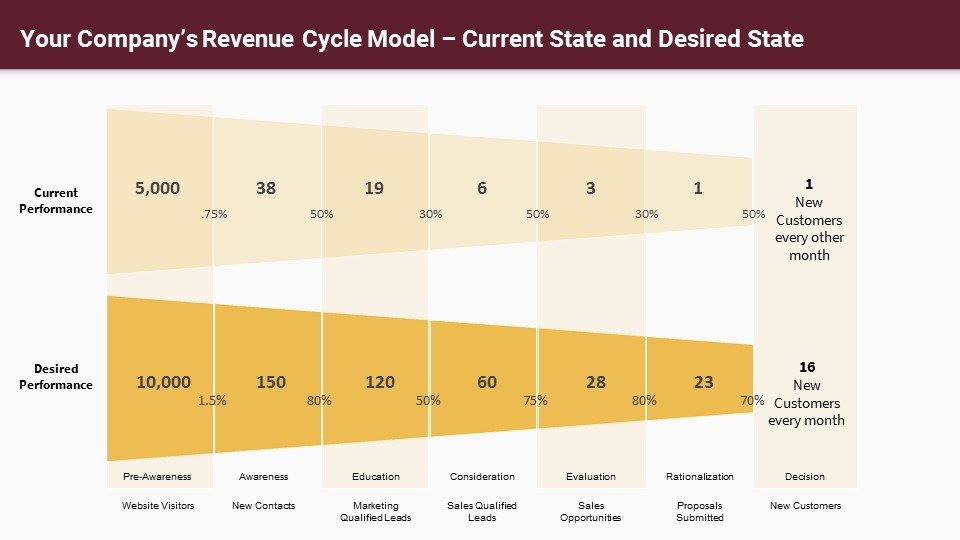
Setting Expectations With Your CEO On Lead Generation And Marketing Results
It Might Be The Hardest Part Of A CRO/CMO’s Role – Setting Expectations For The Organization On Leads And Sales
Think fast – you’re new in the role of CMO and the CEO wants to know how many leads your marketing team can generate this quarter. Or you’re the new CRO and the board wants to know what your revenue growth projections are for the rest of the year.
Do you under-promise and try to over-deliver? Do you try to throw a dart and guess on potential performance? Do you tell them what they want to hear and hope you can deliver?
There is a reason the CMO role has the highest attrition rate.
Setting these performance-based expectations is challenging. Knowing what’s required to then deliver on any promised expectations is even more challenging when there are variables in strategy, tactical deployment, analytics and even the technology used for delivery.
Here are some ways to answer the big question.
Investment
Where do we need to be as an organization? Because with the right resources and budget, I can get us to whatever level we need.
Ultimately, setting expectations is about clearly communicating what can be done (realistically) with the resources you have access to.
Prospective clients come to us all the time with caviar dreams and tuna fish budgets. We have to tell them they won’t go from $1 million in sales to $100 million in sales over the next 12 months for an investment of $1,000 a month.
If the CEO wants to do $1 million a month and each new deal is worth $500,000, then you need two new customers a month. If your close rate is 50%, you need four proposals on the street every month. From here you should be able to back into the exact number of leads required to deliver this level of revenue.
For more on this scientific- and math-based approach to the expectations questions, see the next section.
But this now comes down to resources. If you need 1,000 new leads a month to hit this revenue goal and today you’re only getting 200 leads a month, a big lift is going to be required.
You’re going to need money, people, resources (perhaps outside agency resources), technology and a level of commitment across the entire organization.
While it’s great for the CEO to throw down the mantle and challenge the company, it’s also time to put their money where their mouth is and invest properly to align goals and expectations with an investment in dollars and time.
Without this alignment and without this tight correlation between data, investment, commitment and the expected outcomes, you’re going to fall short on any expectations established.
It’s much better to have these types of conversations now as opposed to later when you miss your numbers or have to explain why it’s taking longer than you thought initially.
Science
Let’s look at the numbers. Lead generation is fairly mathematical. I’ll create a model and we’ll know exactly what we need to do to get to those lead numbers.
As we mentioned above, there is a direct relationship between the math of lead generation and revenue growth with the level of investment. It’s almost impossible to know how much investment will be needed without building a revenue cycle that shows the mathematical relationship between marketing, sales and revenue.
Here’s a sample revenue cycle model that shows you clearly how many visitors, contacts, leads, sales-ready leads, sales opportunities and proposals submitted are needed to generate a certain number of new customers. If you don’t have these numbers for your business, you can’t possibly discuss or set any expectations.

When we build these for clients, the current state is almost always more qualitative than quantitative. Many companies (even big ones) don’t have the marketing automation and CRM systems set up to quickly spit out these numbers.
Instead, it’s a lot of assumptions and guessing. No worries, but we want to quickly move on from that and set up a baseline of actual performance with actual data from properly configured systems.
Now when the CEO says your company needs 1,000 leads by October 31, 100 sales opportunities a month or even 50 new customers this quarter, you can quickly pull up the model, fill in the desired-state numbers and know exactly what level of performance is required at each stage of your revenue cycle.
What you do about that is what we’ll cover in the next section.
Reality Gap
Once we know what we’re doing now, I’ll have a better idea of how long it will take me to get where you want us to be. This has to do with investment, resources and expertise to close the gap.
This is a bit of a blend from the two sections above. Regardless of what the CEO wants, they can’t have it if the budget, resources, commitment, alignment and numbers don’t line up.
Understanding the gap between the desired business outcome (leads) and the current state of the lead generation engine (based on investment and resources) is where the CMO or CRO needs to put their energy.
What’s required to fill in the gap between current performance and desired performance now becomes the tactical game plan for the entire marketing team.
Do you need more visitors to your website? Focus on SEO, paid ads on Google, paid ads on social media sites, more referral marketing, more influencer marketing, more email marketing to the current database, more content creation and placing content on high-volume websites that serve similar audiences. These tactics align with a need to increase numbers early in the buyer journey.
Do you need a higher-quality lead or more sales-qualified leads (people who want to talk to sales)? Focus on content creation around the middle of the buyer journey. Do more webinar or office hours programming. Create more compelling late-stage buyer journey offers for your website. Do more conversion rate optimization on the pages that are already seeing a lot of visitors.
If new customers and actual dollars are the goal, then you might need to improve your close rate on proposals submitted. This might mean better video testimonials or a reference reel. It might mean a revised proposal presentation or a revised agreement with less legalese.
If the investment criteria and corporate alignment are there, it might mean tackling all these issues at the same time. And if the difference between the current state and desired state is wide, this is probably what you should do and everyone in the company should be on board.

Coming To An Agreement
Let’s sit down and review what we want to accomplish and what it’s going to take to get there, then make some decisions around priorities and investment. There might need to be some concessions around these expectations.
Just like any negotiation, both parties generally have to give in at some point. Either your CEO will have to pony up additional investment and/or resources or lower expectations around results.
Typically, it’s a little of both. Your CEO will agree to give some extra money or resources, and you’ll agree to up your goals by a proportional amount.
But what is important is you now have a dialogue that relates results with investment, budget and resource allocation and alignment across the company.
This establishes an ongoing dialogue that should probably take place monthly.
This puts science, math, data and numbers directly behind the conversation, and your ongoing conversations are not about guesses, estimates or projections but based on actual company performance.
If you can’t get beyond 100 leads a month, then don’t think that all of a sudden you’ll be bringing in 500 leads a month. Even if you double the budget, based on your models it’s very unlikely.
Consider Getting Outside Advice To Help Run More Efficiently And Drive Results Faster
Now there are options to consider. For example, if you’ve tapped out the internal team’s capabilities, it might be time to consider outside expertise.
It’s actually very likely that an outside team with a wider collection of experiences and maybe some additional skills could take that 2X budget and deliver 500 leads a month.
That’s because the outside team or agency is bringing systems, processes, methodology, innovation, efficiency and expertise that was missing inside your company.
Some of that might look like experimentation methodology, team configuration and proven best practices from similar companies or similar industries.
For example, when it comes to experimenting, some proven approaches do work wonders:
- Run smaller experiments, but run them more frequently
- Fail fast and learn what not to do again
- Cycle your experiments over shorter time frames to gain insights faster
- Try to practice more disciplined experimentation practices, like resisting the urge to change too many things in a single experiment
- Don’t get hung up on statistical methods; if you have enough data to feel comfortable, you can make solid decisions
You might not know all these tricks unless you’ve been running a lab and executing experiments for hundreds of clients over the past 20 years or so. That’s the value of bringing in someone with skills and experiences not present on your current team.
I’ve been on the agency side and the client side. At this point, I’ve spent just as much time on both sides, so I know all the arguments, all the negotiation points and all the work required to make revenue generation and growth work.
Once you have agreement on what’s required down to the number level, everything does get a lot easier. Everyone is on the same page, budgets and resources are aligned, and support is consistent in every department.
Whether you do it on your own or bring in a team that’s done it 50 times before, it’s now very doable.
You can create the right messages, ensure you’re remarkable, build out the stories and then create the lead generation, demand generation and sales-lead-driving tactics that match up with goals and expectations.
The data helps keep you on track and the technology makes the entire exercise that much easier. Before you know it, you’re upping your expectations because you’ve dialed in your revenue generation machine, and you’re not only hitting but exceeding your revenue goals month over month.

CEO and Chief Revenue Scientist
Mike Lieberman, CEO and Chief Revenue Scientist
Eliminate Hit-or-Miss Marketing Moves
Get advice, tips, tools and guidance to generate more leads for your company in this weekly email newsletter.



Eliminate Hit-or-Miss Marketing Moves
Get advice, tips, tools and guidance to generate more leads for your company in this weekly email newsletter.













